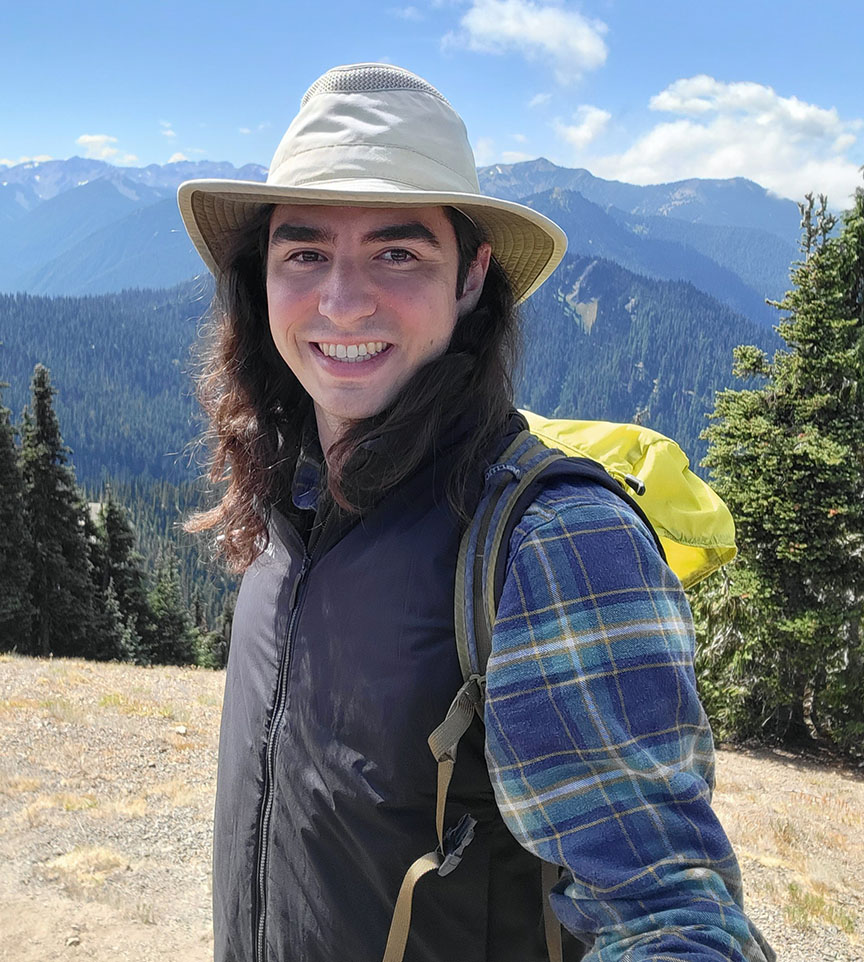“Fluctuation-Dependent Coexistence of Stage-Structured Species”
Chhaya M. Werner, Lauren M. Hallett, and Lauren G. Shoemaker: Read the article
Mechanisms of coexistence are often unintuitive; Werner et al. explore species interactions across different environmental scenarios to bridge theoretical and empirical approaches to coexistence
Living things are constantly competing for what they need to survive and reproduce. One species taking up more food and water means less for other species, and those that cannot compete go extinct. However, if you go outside anywhere, you can find various species of plants and animals living together despite this stiff competition. How can so many species coexist in the same habitat? Part of the answer is that habitats fluctuate over time. One plant might thrive during years with an early spring, while another prefers later springs; so long as there is variation in the timing of spring, one plant species won’t be able to take over the entire landscape.
But do all environmental fluctuations help species coexist? What if the environment fluctuates between wet and dry years? Both plants prefer the rainy years and struggle during droughts. It would seem there is no escape from competition in this scenario, but the two plants still have a chance at coexistence. First, the plants could differ in how well or poorly they do each year. Neither enjoys a drought, but one might be able to store water and better survive these harsh years. Alternatively, one plant might make more of the wet years, growing faster and taller than its competitor and taking up more light. Second, the plant species could differ in how their life cycles align with wet and dry years. One plant could be an annual, a species that lives for only one year and puts all its energy into producing seeds for that year. The other could be perennial, a species that survives over multiple years. The annual plant has no choice but to try and reproduce during drought years. However, the perennial plant could save its energy during droughts, waiting to reproduce once there is rain for its seeds. Either species could also wait out the droughts as seeds; many plants can survive as seeds for multiple years, creating a supply of seeds ready to grow when conditions are good, known as a seed bank. Overall, the two plants perform differently from each other in wet and dry years, which may reduce the competition between them. While diversity in performance across conditions and life history traits is common in nature, most theoretical research aiming to explain how species coexist has focused on simplified environments where species are similar to each other.
Werner and colleagues set out to address this knowledge gap and thoroughly test under what conditions the intersection of environmental variability and differences in life cycle help species coexist. The authors used computer simulations of population growth to investigate scenarios of how species can compete. These scenarios included environmental fluctuations where both species prefer the same conditions, like the plants experiencing drought. The authors included annual species, perennial species, and species with seed banks to see how these life history traits interact with environmental fluctuations. They measured coexistence by simulating one species moving into an environment already dominated by another. If the newcomer could grow its population, the species could coexist. The authors swapped which species was the newcomer for each scenario to control for the advantage species receive by already occupying a habitat.
The authors found that environmental fluctuations had the largest impact on whether species could coexist, but other factors played their own roles. Differences in life cycle generally made coexistence a little more likely, but this result depended on the scenario. When good years were extremely common, annual species that used seed banks struggled to move into an ecosystem. The buildup of seeds in the seed bank kept competition high among the newcomers, preventing them from coexisting with the resident non-seed banking annuals. Alternatively, if the greatest competition for resources occurred in bad years, perennials could prevent other species from moving in. The perennials could carry over the benefits of good years through time and ensure any newcomers experienced high competition every year.
The results of this study are particularly exciting because of what they mean for those planning experiments in nature. The outcomes of competition are measurable in nature, but Werner and colleagues laid out which factors are responsible for these observed outcomes. We could deduce that an environment that consistently gives perennial plants an advantage is primarily water-limited, with the perennials benefiting from the stiffer competition during drought. Ultimately, these findings help us determine how best to maintain diverse ecosystems as environmental cycles change. This research gives us the power to predict in which ecosystems species may no longer be able to coexist, or what management changes could help them do so. We may even gain a better understanding of how to keep invasive species from spreading or prevent native species from being excluded from their habitats.
Jeremy Summers is a PhD student at the University of Rochester studying the demographic and genetic consequences of dispersal in birds. They are also interested in long-term human impacts on species and landscapes and in innovative ways of teaching ecology and evolution. When not talking science, Jeremy enjoys hiking, cooking, and playing board games.
